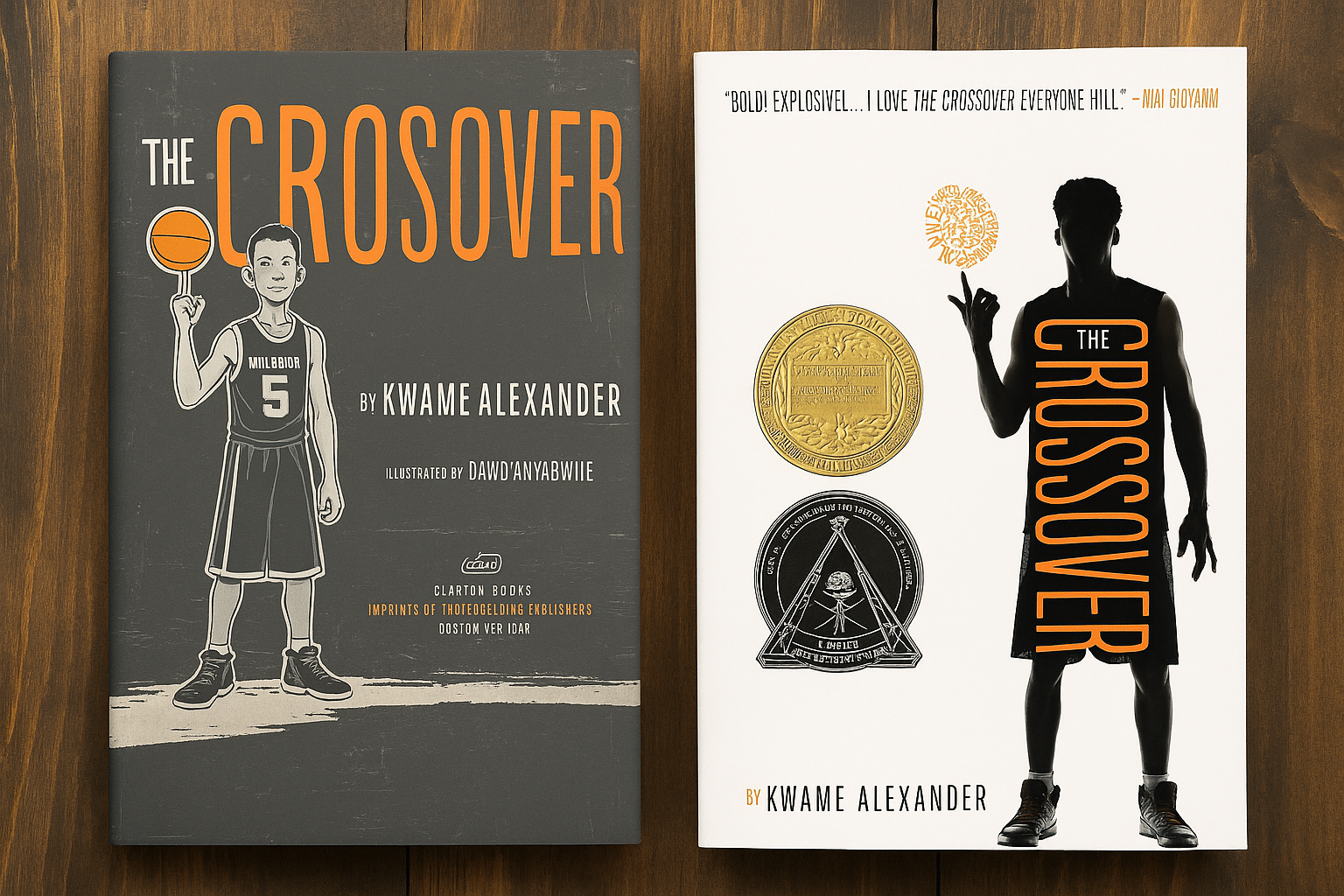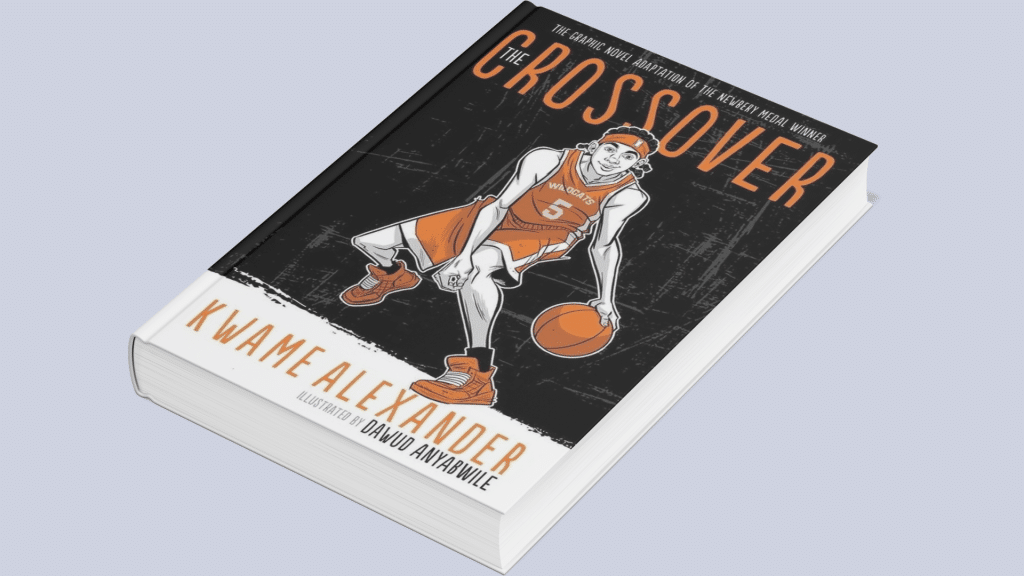I’ve always found that sports stories stay with me because they’re about more than the game; they reveal what it means to grow, struggle, and find strength.
When you read The Crossover by Kwame Alexander, you’ll see that it does this in a way unlike most novels.
Told in quick, sharp verse, it draws you right into the world of Josh and Jordan Bell, twin brothers balancing basketball, family, and the changes that come with growing up.
Today, I’ll show you how the rhythm and emotion work together to make the story unforgettable, leaving you thinking long after the last page. Now, let’s jump in.
The Crossover: Book Summary
The Crossover by Kwame Alexander is a novel in verse about twin brothers Josh and Jordan Bell, who are stars on the basketball court.
Told through Josh’s voice, the story follows their strong bond, growing rivalry, and the challenges of family life.
When their father’s health problems lead to sudden tragedy, the brothers must learn how to deal with loss, find their own identities, and support each other as they grow up.
The book blends basketball action with poetry, making it fun and fast-paced. At its heart, it’s a story about family, love, and finding strength in hard times.
It also shows themes of jealousy, forgiveness, and maturity as Josh struggles with his changing relationship with JB. Through basketball and family bonds, the story highlights how growth often comes through both conflict and healing.
The Crossover: Chapter-by-Chapter Breakdown

The Crossover is told in six parts, each one like a basketball game broken into quarters. Through these sections, we follow Josh and JB as they grow up, face challenges, and deal with both rivalry and loss.
Part 1: Warm-Up
Josh Bell, nicknamed “Filthy McNasty,” introduces himself through his love for basketball and poetry. His words reflect the same pace and energy he brings to the court.
We also meet his twin brother, Jordan (JB), and their parents, Chuck “Da Man” Bell and Crystal Bell. Basketball is central to their family and shapes much of their daily life.
Josh stands out on the court with his speed and different playing style. His skills make him a strong presence in every game he plays.
Part 2: First Quarter
JB begins spending more time with a new girl, Miss Sweet Tea. His attention shifts away from Josh, and the closeness between the twins starts to fade.
Josh feels jealous and left out as the bond he once shared with JB weakens. The change bothers him deeply, and he struggles with the growing distance.
Meanwhile, their father, Chuck, shows early signs of health problems. He brushes them off, but his refusal to take them seriously worries the family and adds tension at home.
Part 3: Second Quarter
The rivalry between Josh and JB grows stronger as their relationship continues to strain. What once felt like teamwork now begins to feel like competition.
JB starts ignoring Josh at school and even during basketball games. This creates visible tension between the brothers, making Josh feel isolated and angry.
At the same time, their father’s heart condition becomes harder to overlook. Despite the symptoms becoming more noticeable, Chuck continues to deny that anything is wrong, leaving the family worried.
Part 4: Third Quarter
During a heated game, Josh loses his temper and accidentally hits JB in the face with a basketball. The moment shocks everyone and shows how much anger he has been holding inside.
The incident sparks a major fight between the brothers, creating an even deeper rift in their relationship. What was once unshakable trust now feels broken.
Not long after, their father collapses during a playful basketball move. The sudden fall is a clear sign that his health issues are far more serious than he has admitted.
Part 5: Fourth Quarter
Chuck suffers a sudden heart attack and is rushed to the hospital. The event shakes the family, turning their world upside down in an instant.
At the hospital, the family struggles with fear and uncertainty. Josh and JB, already distant from each other, are forced to face the possibility of losing their father.
Despite the doctors’ efforts, Chuck passes away. His death leaves Josh, JB, and Crystal heartbroken, forcing them to confront both their grief and the new reality of life without him.
Part 6: Overtime
Josh and JB are left to face their grief after their father’s death. The pain is heavy, but it pushes them to confront the distance that has grown between them.
Josh begins to realize that family, forgiveness, and sticking together matter more than anger or jealousy. He understands that his bond with JB is something he cannot afford to lose.
The twins come together to support their mother, Crystal, as she holds the family together. By honoring their father’s memory, they find strength in each other and begin to heal.
Main Characters and Their Roles
Each character in The Crossover adds something unique to the story. Their choices and struggles shape the way the themes of family, rivalry, and growth play out.
- Josh “Filthy McNasty” Bell: Josh is the narrator who loves basketball and poetry. His main struggle is jealousy when JB spends more time with Miss Sweet Tea. By the end, he learns the importance of forgiveness and family.
- Jordan “JB” Bell: JB is Josh’s twin and equal on the court. He matures faster, showing interest in relationships. His bond with Miss Sweet Tea creates distance between him and Josh.
- Chuck “Da Man” Bell: Chuck is the twins’ father and a former pro player. He coaches the boys but ignores his heart problems. His sudden death forces Josh and JB to grow up.
- Crystal Bell: Crystal is the twins’ mother and assistant principal. She worries about Chuck’s health and becomes the family’s anchor after his death.
- Miss Sweet Tea: Miss Sweet Tea is the new girl who draws JB’s attention. She causes rivalry between the brothers and pushes Josh to face his jealousy.
Together, these characters show how love, loss, and change can impact a family. Their connections make the story both heartfelt and memorable.
Key Themes and Motifs
The Crossover highlights several themes that make the story meaningful. Each one shows how basketball, family, and personal growth connect in powerful ways.
1. Brotherhood and Rivalry
Josh and JB share a tight bond as twins, but that connection is tested when JB grows closer to Miss Sweet Tea. Their rivalry shows how even siblings who love each other can struggle with jealousy and distance, while also proving that trust and forgiveness can bring them back together.
2. Family, Love, and Loss
At the center of the story is family. The Bells face Chuck’s sudden death, and it shakes their world. Through grief, they learn that love and unity are what hold them together, even in the hardest moments.
3. Coming of Age
Growing up isn’t easy for Josh and JB. Between jealousy, change, and loss, they face situations that force them to mature. By the end, they both begin to understand responsibility and what it means to grow into their own paths.
4. Identity and Individuality
The twins often get seen as a pair, but they’re also figuring out who they are as individuals. Josh and JB each learn to embrace their own strengths and interests, while still valuing the bond that makes them brothers.
5. Symbolism of Basketball and Crossover Moves
Basketball isn’t just a sport in this story; it’s the language of the family. The crossover move, in particular, becomes a symbol of change and adaptation, showing how life, like the game, requires quick adjustments and resilience.
These themes give The Crossover more than just fast-paced basketball action. They turn it into a story about love, growth, and finding strength in the face of change.
How the Story is Told
What makes The Crossover stand out is the way it’s written. Instead of long chapters, the story unfolds in free verse, which makes it feel quick and alive on the page.
The short poems create the same rhythm as a basketball game: fast, sharp, and full of energy. When the lines stretch out, you can feel the weight of big moments, almost like the game slowing down before a key shot.
Basketball terms weave into the poetry, so every play becomes part of the story itself. It shows how deeply Josh connects the game to his own voice and identity.
This style doesn’t just make the book easier to read; it makes it unforgettable, combining the speed of the court with the rhythm of words.
About the Author

Kwame Alexander isn’t just an author; he’s a poet and educator who has written more than 30 books for young readers.
The Crossover, published in 2014, is his most famous work and even won the 2015 Newbery Medal along with the Coretta Scott King Honor.
What makes his writing stand out is how he mixes poetry with real-life themes like family, identity, and resilience. His stories are quick to read but stay with you long after, especially for kids who may not usually enjoy traditional novels.
Beyond writing, Alexander works hard to promote literacy. He visits schools, runs workshops, and encourages students to use writing as a way to find their own voices.
Alongside The Crossover, his other well-known books include Booked, Rebound, and The Undefeated.
Where to Purchase The Crossover
If you’re ready to read The Crossover, it’s easy to find in different formats. Here are a few trusted places to check:
- Amazon: Hardcover, paperback, Kindle, and audiobook
- Barnes & Noble: Print and Nook ebook
- Target.com: Print editions available online
- Walmart.com: Hardcover and paperback
- Books-A-Million (BAM): Multiple formats with online shipping
Whether you like holding a book, reading on a screen, or listening on the go, you’ll have no trouble getting a version that works for you.
TV Adaptation: The Crossover Series
In April 2023, The Crossover came to life as a Disney+ series. It follows Josh and JB not just as basketball players, but as brothers juggling family life, school, and growing up.
The show keeps the mix of sports, drama, and even bits of poetry that made the book so unique. It feels fast and emotional, just like the original story.
There are some differences, though. The series expands on side characters and gives more space to school life, so it can fill out a full season. Dialogue takes the lead where the book used verse, and a few scenes are stretched out to give more detail to relationships.
If you enjoyed the book, the show offers a fresh way to connect with Josh and JB’s story. It doesn’t replace the novel but adds new layers that fans can appreciate.
Reader Takeaways
When I finished the book, a few lessons stood out to me. You’ll probably notice some of these as you read, and maybe even connect them to your own life:
- Sports and art aren’t as far apart as they seem; they can both be ways to express yourself.
- The struggles teens face, like rivalry and change, feel real and relatable.
- Family ties may stretch under pressure, but love can bring them back together.
- Grief hurts, but it can also create strength and closeness.
- Finding your identity means carving your own path while still valuing your connections.
These takeaways remind me that The Crossover is more than a basketball story; it’s about growing up, facing challenges, and learning what really matters.
Should You Read The Crossover: My Final Recommendation
I’d say yes; it’s absolutely worth your time. The story blends basketball and poetry in a way that’s fast, fun, and surprisingly moving.
You’ll find themes of family, brotherhood, love, and loss that connect well beyond the game. Even if you’re not into sports, the emotions feel real and hit home.
If you’re a student, a teacher, or just someone who enjoys a story that sticks with you, The Crossover is one I’d recommend.
Wrapping Up
When I think back on the book, what stays with me isn’t just the basketball; it’s the way the story captures growing up, handling change, and holding on to the people who matter most.
You’ll notice how Kwame Alexander uses poetry to make even heavy moments feel alive, giving you a reading experience that’s both quick and deeply meaningful.
It’s the kind of book that reminds us stories can be fast-paced and heartfelt at the same time.
If you enjoyed this Crossover summary and want more, check out my other book breakdowns and literature guides to keep reading stories that inspire.
Frequently Asked Questions
Is The Crossover based on a true story?
No, it is a work of fiction. However, Kwame Alexander drew inspiration from real experiences with basketball, family life, and growing up.
What age group is The Crossover best for?
The book is aimed at middle-grade readers (ages 9-13), but its themes make it meaningful for older students and even adults.











